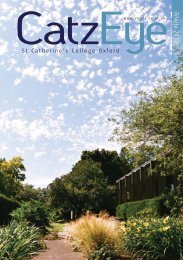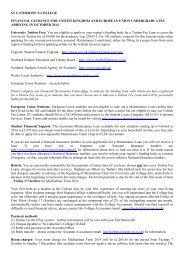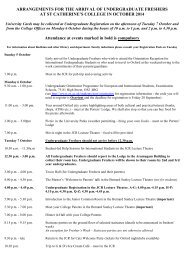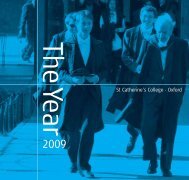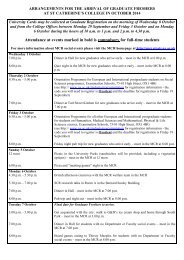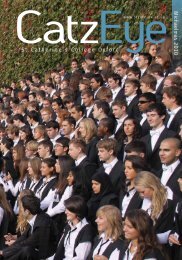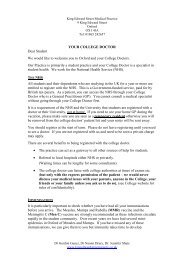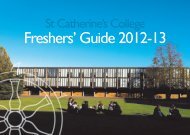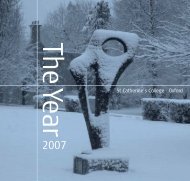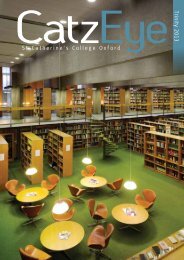Download PDF - St. Catherine's College - University of Oxford
Download PDF - St. Catherine's College - University of Oxford
Download PDF - St. Catherine's College - University of Oxford
You also want an ePaper? Increase the reach of your titles
YUMPU automatically turns print PDFs into web optimized ePapers that Google loves.
ALUMNI NEWS<br />
Matthew Yeo (2001, History) on publishing his latest book about Chetham’s Library<br />
Matthew Yeo has recently published his first<br />
book, The Acquisition <strong>of</strong> Books by Chetham’s<br />
Library, 1655-1700, a detailed study <strong>of</strong> the<br />
way in which the early modern provincial<br />
library was created, stocked and administered.<br />
The result is a refreshing reinterpretation <strong>of</strong><br />
provincial intellectual culture, and <strong>of</strong> the early<br />
modern trade in books and ideas.<br />
‘It is true that a fair Librarie, is not onely an<br />
ornament and credit to the place where it<br />
is; but a useful commoditie by itself to the<br />
publick; yet in effect it is no more than a Dead<br />
Bodie as now it is constituted, in comparison<br />
<strong>of</strong> what it might bee, if it were animated<br />
with a publick Spirit to keep and use it, and<br />
ordered as it might bee for publick Service’. 1<br />
Chetham’s Library was founded at a time<br />
when libraries were at the forefront <strong>of</strong> many<br />
scholars’ minds. Although the connection is<br />
coincidental, this quotation from the Reformed<br />
Librarie-Keeper by John Durie is all the more<br />
pertinent to the study <strong>of</strong> Chetham’s Library<br />
because it was published by Robert Littlebury,<br />
the publisher and bookseller who supplied<br />
books to the Library between 1655 and the<br />
1. John Durie, The Reformed-School And the Reformed<br />
Librarie-Keeper (London: Robert Littlebury, 1651).<br />
Image courtesy <strong>of</strong> the Librarian and Fe<strong>of</strong>fees <strong>of</strong> Chetham’s<br />
Library<br />
end <strong>of</strong> the seventeenth century. Books had<br />
to be arranged on the shelves in order to<br />
facilitate an easy transition from one book to<br />
another. Durie captured the importance <strong>of</strong> the<br />
usefulness <strong>of</strong> books to early modern readers.<br />
Libraries were not just beautiful additions to<br />
houses or communities, but had to provide a<br />
service. Durie’s work lamented the reduction<br />
<strong>of</strong> librarianship to mere conservation, and<br />
he looked back to an earlier age <strong>of</strong> activist<br />
Protestant librarianship, in which the library<br />
was a knowledge factory.<br />
At Chetham’s Library in the seventeenth<br />
century, many books were read selectively.<br />
These works, such as biblical concordances and<br />
harmonies, formed a large part <strong>of</strong> the Library’s<br />
earliest purchases, intended to combat the<br />
‘information overload’ generated by the fruits<br />
<strong>of</strong> the printing press. The scholarly value <strong>of</strong><br />
these books came not from the persuasiveness<br />
<strong>of</strong> their arguments. Instead, it was derived<br />
from the capaciousness <strong>of</strong> the indexes and<br />
from readers’ strategies to wade through the<br />
huge number <strong>of</strong> texts to be read. These were<br />
books that indicated that the reader was an<br />
active and creative participant in the creation<br />
<strong>of</strong> meaning from the text. Early modern<br />
readers acknowledged the fact that books<br />
were for use, and increasingly, historians <strong>of</strong><br />
the early modern period recognise it too.<br />
Readers in libraries acknowledge that libraries<br />
have to be organised to make them useful<br />
rather than just repositories <strong>of</strong> books.<br />
They provide ‘standards <strong>of</strong> coherence’ by<br />
which readers understand the texts they<br />
read, which include catalogues, shelving<br />
and practices <strong>of</strong> storage and retrieval. The<br />
‘intelligencer’ Samuel Hartlib made efforts in<br />
the seventeenth century to create coherent<br />
bodies <strong>of</strong> knowledge, and corresponded<br />
with John Worthington, a regular visitor to<br />
Chetham’s Library, to discuss how to perfect<br />
catalogues and indexes for books in libraries.<br />
For Hartlib, a librarian, and particularly one<br />
responsible for a scientific library, had to<br />
become ‘a factor and trader for helpes to<br />
learning, a treasurer to keep them and a<br />
dispenser to apply them to use, or see them<br />
well used, or at least not abused’.<br />
Libraries and librarians were important<br />
elements in the early modern trade in books<br />
and ideas. However, there is a real danger<br />
in the inference that libraries simply store<br />
the products <strong>of</strong> the book trade. The study <strong>of</strong><br />
early modern libraries must work outwards<br />
from a Library’s acquisition and ownership <strong>of</strong><br />
a book, through a multitude <strong>of</strong> issues around<br />
intellectual content, material forms and the<br />
book trade, to the reading and employment<br />
<strong>of</strong> texts in the early modern period. n<br />
ST CATHERINE’S COLLEGE 2012/43



